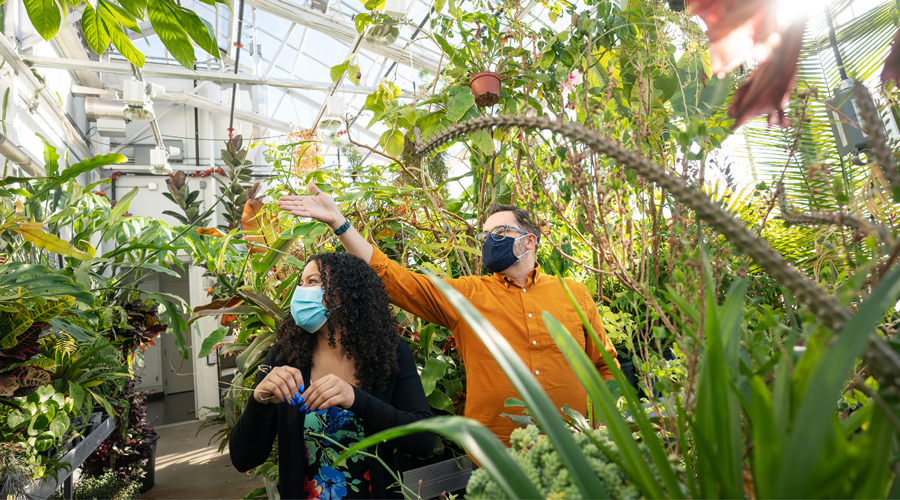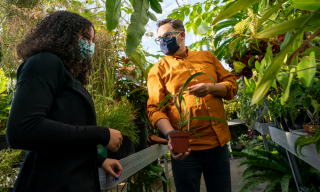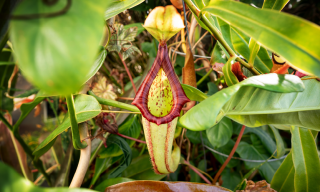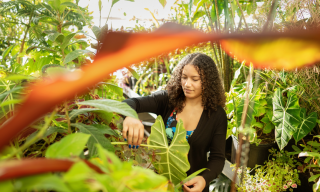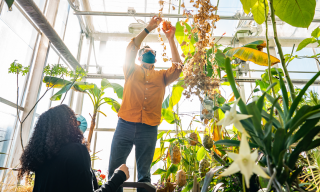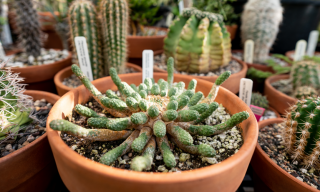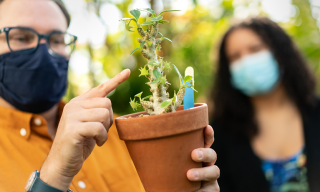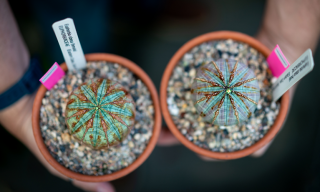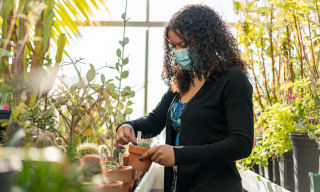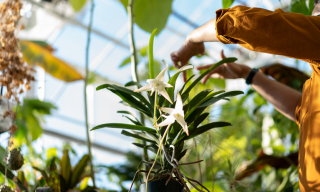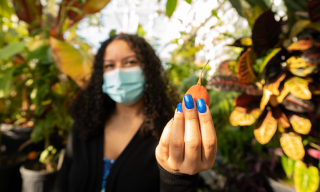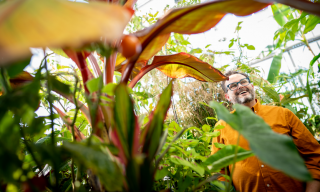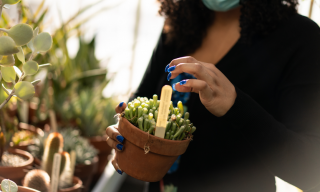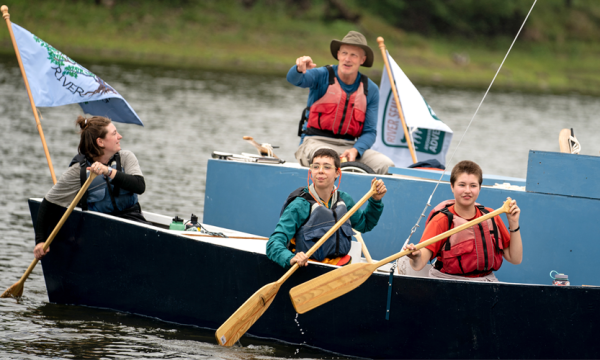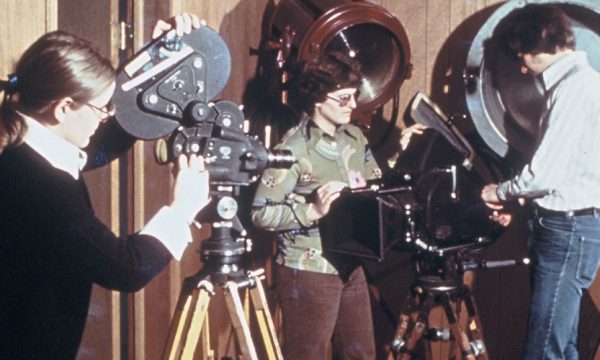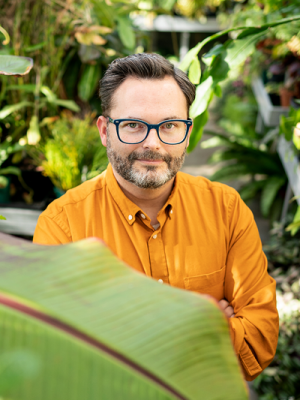
Perched atop Augsburg University’s newest and largest academic building—the Norman and Evangeline Hagfors Center for Science, Business, and Religion—a greenhouse fosters a diverse collection of plants whose origins span the globe.
Sustaining such a vibrant space filled with hundreds of plant species requires attentive eyes and careful hands. Between teaching biology courses and managing the Biology Department Plant Growth Facilities (including the greenhouse), Assistant Professor Leon Van Eck discussed Augsburg’s diverse greenhouse collection, noteworthy specimens, and the challenges he and student-workers experience while cultivating so many plants. Plus, don’t miss his advice for plant care at home.
Q: What is the origin story of Augsburg’s greenhouse? How did you get involved?
A: The rooftop greenhouse was already envisioned in the early designs for the Hagfors Center. I was not involved in designing or building these facilities, as I started my position at Augsburg in January 2018, right when the Hagfors Center officially opened. The completed Plant Growth Facilities of the biology department include the 500-square-foot rooftop greenhouse, a headhouse used as general plant maintenance space, as well as two climate-controlled walk-in plant growth rooms and four reach-in plant growth chambers.
It was my vision that the greenhouse be used to support a permanent plant collection, while the growth rooms and chambers be used for labs, research experiments, and plant tissue culture requiring more precise control of growing conditions. The growth chambers also house my plant-pest interaction research program’s aphid colony, so you might say that we also manage the largest animal collection on the Augsburg campus as well!
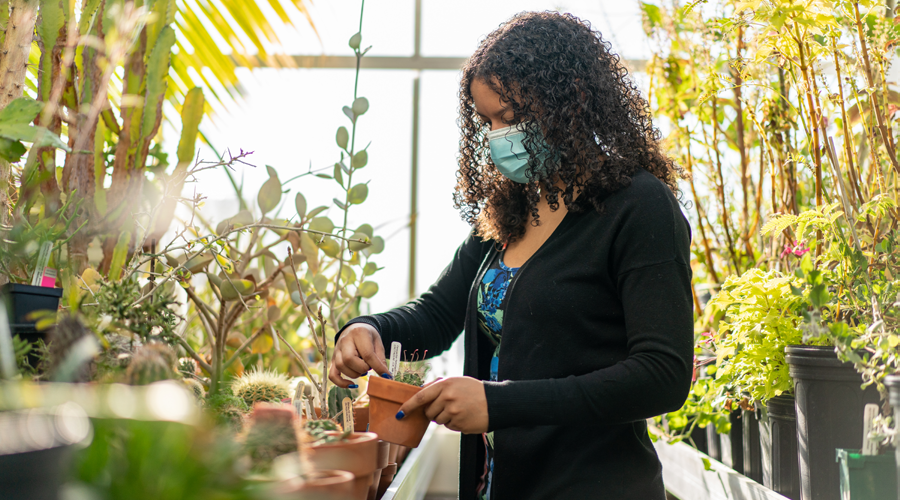
Q: What are some of the most remarkable plants in the greenhouse? How did they come to be at Augsburg?
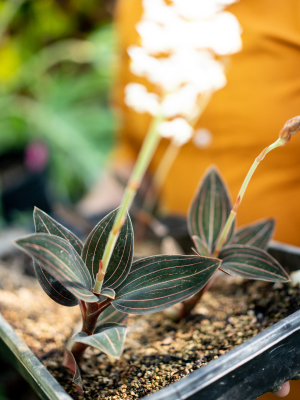
A: The majority of the plant collection has been acquired through purchase from specialist growers, using funds from Augsburg donors or from our annual plant sale in collaboration with the Augsburg chapter of the TriBeta Biology Honor Society. I’ve also managed to leverage my connections at botanical institutions for some important additions to the collection. For example, in 2021, the United States Botanic Garden in Washington, D.C., kindly gifted us two specimens of the titan arum (Amorphophallus titanum), also sometimes called the corpse flower. This endangered aroid from the island of Sumatra is famous for producing an enormous and strikingly foul-smelling inflorescence that has people lining up at conservatories and botanical institutions around the world during a blooming event. Our specimens are still a few years away from producing their first flowers, but they have adjusted to life in Minnesota and are growing rapidly.
We also recently acquired five rare and endangered species of Central American cycad, thanks to the kind horticulturalists at the Amazon Spheres in Seattle. A colleague who specializes in the study of African carnivorous plants sent me a very nice specimen of Roridula gorgonias, the flycatcher bush. Incidentally, I just returned from a trip to South Africa, where I was able to visit a large colony of these remarkable plants in their marshy habitat, high in the coastal mountains of the Western Cape province.
Q: What are the most challenging plants or issues to deal with when managing a greenhouse’s collection and environment?
A: Even though the greenhouse has computer-controlled climate systems, getting a diverse plant collection to thrive under a single roof remains a challenge. How do the student workers and I maintain tender ferns and arid-adapted succulents all in one place? The answer lies in micro-climates. By carefully observing seasonal variation and individual plant responses, we’ve dialed in the best positions in the greenhouse to give sun-loving species the most light, and protect denizens of the forest floor under a shady canopy of larger plants. Pest outbreaks are unfortunately also a reality when you have a greenhouse in the sky, but we’ve developed a tight rotation of various organic controls to good effect.
As for challenging plants, thus far, the majority of the 400 species grow pretty well for us. Some stapeliads from Somalia succumbed to over-enthusiastic watering early on, so now I caution student workers to keep that group of plants on the dry side. What remains a challenge is to coax some species, such as certain cacti and many of our pelargoniums, into bloom. These plants require significant drops in nighttime temperatures to stimulate flower development, but for the protection of our most tropical species, we keep greenhouse temperatures pretty toasty.
Q: How does Augsburg’s greenhouse fit into the academic and community life at the university? How do students benefit from the greenhouse?
A: The greenhouse is open to visitors on the afternoon of the first Thursday of every month. These events have been very popular with students and staff, particularly when it’s cold and dreary outside!
As curator of the permanent plant collection, it is important to me to be thoughtful about which species are acquired for the collection. The permanent plant collection is used extensively in teaching in the biology department, and to best support this we cultivate species from a wide array of taxonomic groups, from liverworts, clubmosses, and horsetails to conifers and diverse flowering plants. We also have plants that are useful in teaching students about evolutionary biology, such as a passionflower vine that has evolved yellow leaf spots that mimic the eggs of swallowtail butterflies. Since the caterpillars of these butterflies are aggressive and cannibalistic, the butterflies avoid plants with eggs already present when depositing their own, in the hope of giving their offspring the best chance of survival. This egg mimic thus cleverly avoids becoming a meal for hungry insects! Plants that help to tell impactful stories about ecology, adaptation, and diversity are useful tools in the classroom.
It is also important to me that the diversity of our collection reflects something of the diversity of the Augsburg community, so plants native to the Horn of Africa form an important focus. In the case of Somali wild cotton (Gossypium somalense), there is crossover with another focus of the collection, which is the wild or under-domesticated relatives of familiar crop species. Wild barley from Turkmenistan and wild tomatoes from Peru are examples of what we have in the greenhouse. These can often be the source of genes conferring useful traits like disease or drought tolerance, important tools for sustainable agriculture in the face of climate change. Students in our BIO 151 Introductory Biology labs isolate and sequence the DNA of some of our plants, while students in BIO 475 Neurobiology get to extract alkaloids from some of our most toxic nightshade relatives to test their effect on heart muscle cells!
The greenhouse isn’t used exclusively by the biology majors, of course. Art students use the plants for an exercise in understanding negative space, and history students have dropped by for a lesson on the domestication of crops.
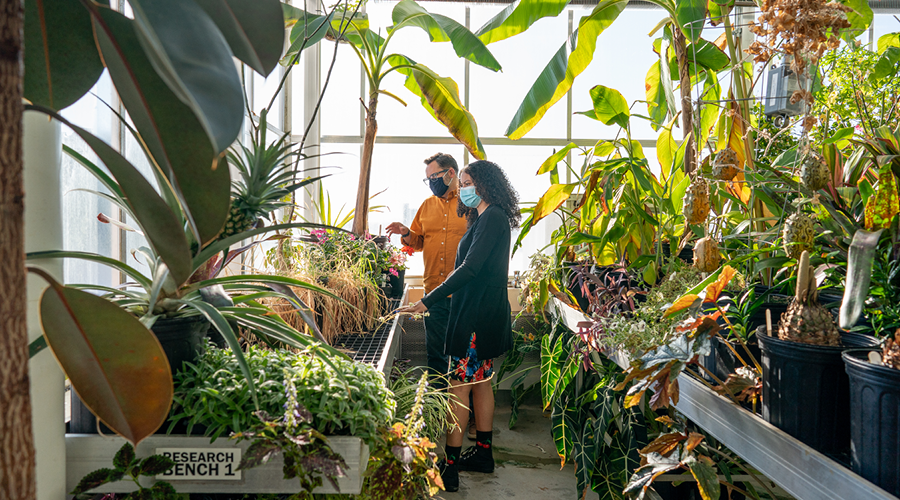
Q: For anyone who adopted a plant during the pandemic or just wants to care well for their plants at home, what advice do you offer?
A: Black thumbs don’t exist; even professional growers have killed plants under their care. It’s part of how we learn to grow these amazing organisms. If your plant isn’t doing well, change one parameter at a time, and observe your plant for a few weeks before changing something again. Most plants decline because of overwatering or insufficient light. If you’re unsure about watering, err on the side of watering less. If you’re unsure about light, err on the side of brighter light. And keep your houseplants away from cold draughts and drying furnace vents.
See Augsburg’s greenhouse:
- Visitors are welcome during the afternoon of the first Thursday each month.
- Follow @augsburg_greenhouse on Instagram.
Top image: Augsburg’s greenhouse provides a warm, vibrant environment for Auggies to enjoy all year round. (Photo by Courtney Perry)


